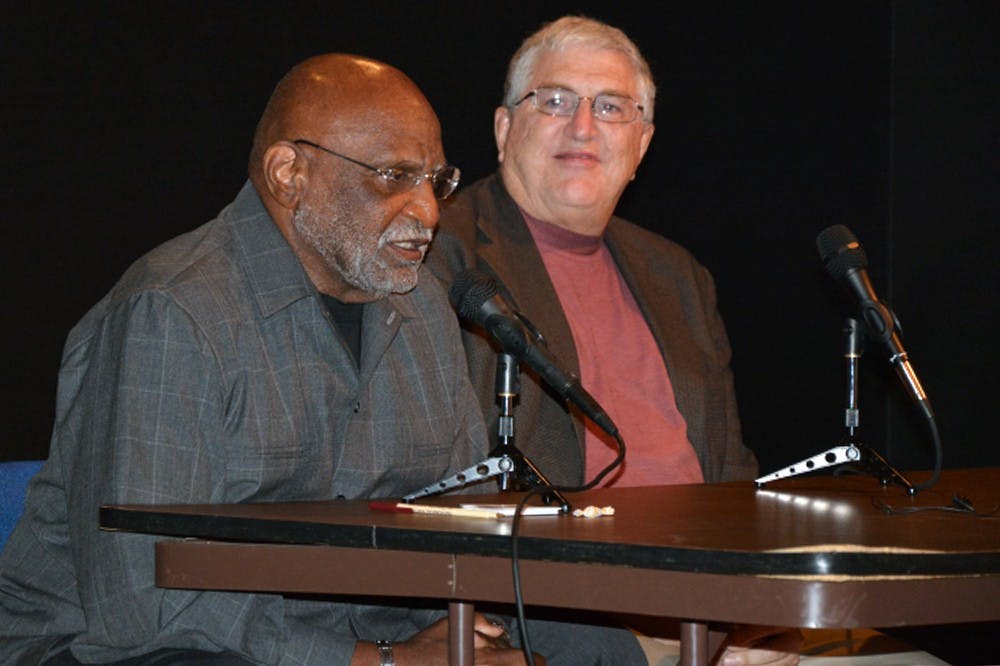Believing that MSU has not received proper recognition for its role in the integration of college football, class of 1978 MSU graduate and former State News employee Tom Shanahan wrote Raye of Light to fully explain the Spartans and former head coach Duffy Daugherty’s impact on college football.
In 1966, during his junior year, Jimmy Raye became MSU’s first black starting quarterback, ultimately becoming the first black quarterback from the south to win a national title by the end of the season.
“There was a time when black athletes weren’t trusted, they weren’t considered smart enough to play quarterback or middle linebacker — the positions that require making calls,” Shanahan said. “The coaches, who were all white, didn’t necessarily go looking for black players to recruit and then Duffy changed that.”
Former Indianapolis Colts coach and the first African-American head coach to win a Super Bowl Tony Dungy wrote the foreword in the book.
“In 1963 ... my dad who was a college professor, decided to attend Michigan State to work on his PhD. Football Saturdays at Michigan State were special events for me,” Dungy wrote. “But there was one other reason I became so enamored with the Spartans. When I went to watch them play, there were African-Americans on those teams — and they were not just simply on the team, they were playing major roles.
“As a 9- or 10-year-old, I couldn’t really tell you at the time why that had such an impact on me. I just knew there were guys going to school and playing at Michigan State who looked like me. This book documents the efforts of Duffy Daugherty and his staff in recruiting black players from the south, for many of those players, their only other choices were historically black colleges and universities, but suddenly the world of major-college football was opening up to them.”
Dungy considered attending MSU and playing for the Spartans but after his senior season of high school in 1972 Daugherty retired and the MSU assistant that recruited Raye, Cal Stoll, took the head coaching job at Minnesota — ultimately convincing Dungy to build a legacy of his own.
Shanahan believes that some of the reason this history is overlooked is because of the result of the “Game of the Century,” a 10-10 tie between Notre Dame and MSU with both teams having been undefeated heading into the game.
The two teams were each named champions by different polls and Shanahan believes a victory would have made that MSU team more relevant today.
Shanahan set out to dispel the idea that Daugherty only recruited a handful of very talented black athletes from the south. In his research Shanahan found out that he recruited 44 guys from the south between 1959 and 1972 all of whom did not become stars and All-Americans.
“Turns out he brought up 44 guys from the south, obviously they weren’t 44 All-Americans,” Shanahan said. “A lot of those guys were just grateful to escape the south, get an education and go on to successful careers.”
Daugherty never recaptured the wild success he experienced in 1965 and 66 in his remaining years and Shanahan believes that also plays a factor in MSU’s lack of recognition.
MSU’s 1966 team had 20 black players on it, which may not sound like much today, but comparatively Southern California’s 1967 national championship team only had seven black players, Alabama didn’t dress its first black player in a varsity game until 1971, LSU and Georgia didn’t field their first black players in a varsity game until 1972.
“Duffy had six black players from the south in his final recruiting class in 1972,” Shanahan said. “He had more black players in his 1972 freshman class than SEC schools had on their entire roster.”
The most rewarding result of writing this book for Shanahan has been has been the responses from alumni.
“The most rewarding response I’ve received from alumni is they are proud to learn that their school was on the right side of history,” Shanahan said. “That is true for older alumni that learned more about the era from the book and younger alumni that knew little about Michigan State’s impact on the integration of college football.”







